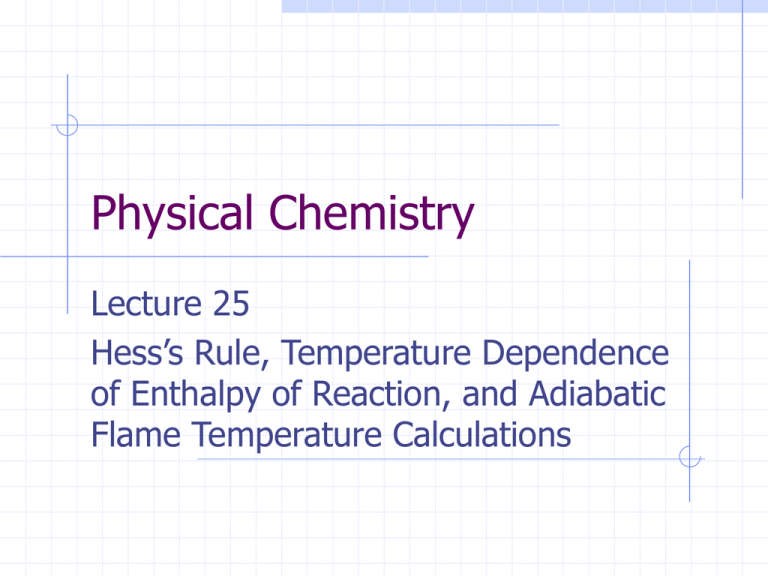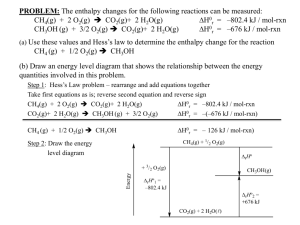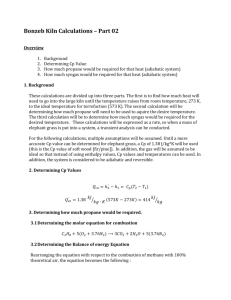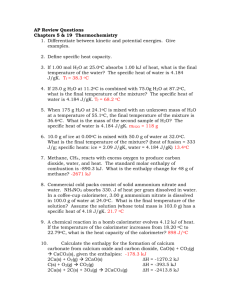Physical Chemistry
advertisement

Physical Chemistry Lecture 25 Hess’s Rule, Temperature Dependence of Enthalpy of Reaction, and Adiabatic Flame Temperature Calculations Thermodynamics of reaction processes Often faced with the need to calculate the change of a thermodynamic variable in a reaction that may not be tabulated C2 H 4 ( g ) + H 2 ( g ) → C2 H 6 ( g ) N 2O ( g ) + 3 O2 ( g ) → N 2O4 ( g ) 2 Applies to all thermodynamic variable ∆H reaction ∆S reaction ∆U reaction ∆Areaction ∆Greaction Cyclic properties of thermodynamic functions Consider a cycle involving reaction Change in a thermodynamic variable Change through a cycle is zero Change along one path between two states must equal that along another connecting the two states True for ∆H, ∆U, ∆S, ∆A, ∆G Hess’s rule The cyclic property involving reaction is codified in Hess’s rule ∆H reaction = ∑ν k ∆ f H k ,m k True of any state function ∆U reaction = ∑ν k ∆ f U k ,m k ∆S reaction = ∑ν k ∆ f S k ,m ∑ν k ∆ f Ak ,m k ∆Areaction = k ∆Greaction = ∑ν k k ∆ f Gk ,m Hess’s rule and combustions The cyclic property is also true when the intermediate state is the stable oxides ∆H reaction = − ∑ν k ∆H k ,m , combustion k ∆U reaction = − ∑ν k ∆U k ,m , combustion k ∆S reaction = − ∑ν k ∆S k ,m , combustion k ∆Areaction = − ∑ν k ∆Ak ,m , combustion k ∆Greaction = − ∑ν k ∆Gk ,m , combustion k Example: Boudouard’s reaction Reaction C ( gr ) + CO2 ( g ) → 2 CO ( g ) By Hess’s rule θ ∆H reaction (298.15 K ) = 2 ∆ f H mθ (CO ) − ∆ f H mθ (C ) − ∆ f H mθ (CO2 ) From Table 6.1, one can find the enthalpies of formation θ ∆H reaction (298.15 K ) = 2 (−110.525 kJ ) − (0 kJ ) − (−393.509 kJ ) = 172.459 kJ Enthalpies and energies of formation of elements are zero, by definition Temperature dependence of thermodynamic quantities Chemical reactions are often carried out at temperatures other than those for which information is tabulated Use cyclic properties to determine changes in thermodynamic properties at other temperatures Temperature dependence of enthalpy of reaction Enthalpy change is independent of the path ∆H reaction (T2 ) = ∆H1 + ∆H reaction (T1 ) + ∆H 2 The two steps are simply heating of materials ∆H reaction (T2 ) = T1 ∫C P , reactants (T )dT + ∆H reaction (T1 ) + T2 = ∆H reaction (T1 ) + T2 ∫C P , products T1 T2 ∫ ∆C P (T )dT T1 Evaluation of the heat-capacity difference allows estimate of enthalpy change at different temperature (T )dT Temperature dependence of thermodynamic quantities Determining temperature dependence involves evaluation of change for both reactants and products T2 θ C ∆ ∫ P (T )dT θ θ (T2 ) = ∆H reaction (T1 ) + ∆H reaction T1 T2 θ C ∆ ∫ V (T )dT θ θ (T2 ) = ∆U reaction (T1 ) + ∆U reaction T1 θ C ∆ θ θ P (T ) dT (T2 ) = ∆S reaction (T1 ) + ∫ ∆S reaction T T1 T2 Adiabatic flame temperature Question: What is the temperature in a flame? Can answer this question in a limit Heat generated raises temperature of the products No losses of heat – adiabatic process Solve for T2, adiabatic flame temperature Can be difficult because it may be a complex equation in T2 Must know what materials are “products” T2 θ C ∫ P, products (T )dT T1 θ = − ∆H combustion (T1 ) Adiabatic flame temperatures Fuel Oxidizer Reaction Tad (K) Hydrogen Oxygen H2 + ½ O2 H2O 3100 Methane Oxygen CH4 + 2 O2 CO2 + 2 H2O 3000 Methane Air CH4 + 2 O2 + 8 N2 CO2 + 2 H2O + 8 N2 2200 Octane Oxygen C8H18 + 25/2 O2 8 CO2 + 9 H2O 3100 Acetylene Oxygen C2H2 + 5 O2 4 CO2 + 2 H2O 3300 Cyanogen Oxygen C2N2 + 5 O2 2 CO2 + N2 4800 Producer gas Air 2 CO + 4 H2 + 3 O2 + 12 N2 2 CO2 + 4 H2O + 12 N2 2400 Methylhydrazine Nitrogen tetroxide CH2NH2 + N2O4 2 H2O + CO2 + 2 N2 3000 Summary Hess’s rule allows estimation of thermodynamic changes for a wide variety of chemical reactions Use of thermodynamic cycles allows estimation of thermodynamic changes at conditions other than those in tables, particularly at other temperatures Adiabatic flame temperature calculation relies on a similar cyclic calculation





